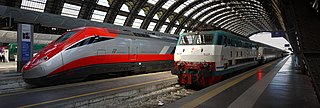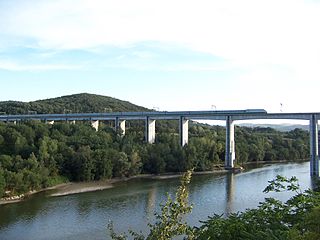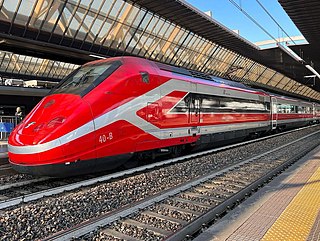This article needs additional citations for verification .(June 2024) |
Eurostar Italia was the brand name given to high-speed trains operated by Trenitalia in Italy. The brand was discontinued and replaced with Le Frecce in December 2012.
This article needs additional citations for verification .(June 2024) |
Eurostar Italia was the brand name given to high-speed trains operated by Trenitalia in Italy. The brand was discontinued and replaced with Le Frecce in December 2012.

Eurostar trains, which were launched in 1997 to replace the Pendolino trains, were always for the line from Milan to Rome and its expansions. The Italian state railroad claimed the name "Eurostar" prior to the Eurostar connecting London to Paris. [1]
Since 2006 with the opening of the high speed lines the category gradually declined in several subcategories and the original gradually downsized. In June 2012, the category Eurostar was divided into various subcategories under a new branding, indicating various high-speed services. The new categories created were Frecciarossa for the fastest trains (300 km/h (186 mph)), Frecciargento for the next category of trains (250 km/h (155 mph)), and Frecciabianca (200 km/h (125 mph)). The final Eurostar services connecting Rome with Ravenna and Reggio Calabria operated until December 2012.
The name Eurostar was used under license from Iveco, which owns the trademark and used the name for one of their trucks. Despite the identical name, there is no relation between this service and the Eurostar railway service that runs through the Channel Tunnel.
Various categories used until June 2012 were:

Bologna Centrale is the main railway station in Bologna, Italy. The station is situated at the northern edge of the city centre. It is located at the southern end of the Milan-Bologna high-speed line, which opened on 13 December 2008, and the northern end of three lines between Bologna and Florence: the original Bologna-Florence line through Porretta Terme and Pistoia; the Bologna–Florence Direttissima via Prato, which opened on 22 April 1934 and the Bologna-Florence high-speed line, which opened to traffic on 13 December 2009.

The Italian railway system is one of the most important parts of the infrastructure of Italy, with a total length of 24,567 km (15,265 mi) of which active lines are 16,832 km (10,459 mi). The network has recently grown with the construction of the new high-speed rail network. Italy is a member of the International Union of Railways (UIC). The UIC Country Code for Italy is 83.

ETR 450 was the first series Italian tilting train.
ETR is a series of Italian high-speed trains.

Roma Termini is the main railway station of Rome, Italy. It is named after the district of the same name, which in turn took its name from ancient Baths of Diocletian, which lies across the street from the main entrance. It is Italy's busiest railway station and the fifth-busiest in Europe, with a traffic volume of approximately 150 million passengers per year, and with 850 trains in transit per day.

High-speed rail in Italy consists of two lines connecting most of the country's major cities. The first line connects Turin to Salerno via Milan, Bologna, Florence, Rome and Naples, the second runs from Turin to Venice via Milan and Verona, and is under construction in parts. Trains are operated with a top speed of 300 km/h (190 mph).

Napoli Centrale is the main railway station in the city of Naples and in southern Italy and the sixth largest station in Italy in terms of passenger flow with an annual ridership of 50 million. It is located next to Piazza Garibaldi to the east of the old city. It is the primary rail terminus and station for Naples, and serves Trenitalia national railways and EAV. This one has an underground section known as Stazione di Napoli Piazza Garibaldi, which is served by the metropolitan trains of the line 2, line 1 (Garibaldi), and 3, 12, 14, and 15 EAV Circumvesuviana lines which is accessible from 2 entrances inside the Centrale station, 1 outside in glass, and from the new Garibaldi Square.

Salerno railway station serves the Italian city of Salerno and was opened in 1866. It is the main railway station of the city.

Torino Porta Susa is a railway station in Turin, northern Italy; it is the second busiest mainline station in the city, after Torino Porta Nuova. It is located in Corso Inghilterra.

Parma is a railway station serving the city of Parma, in the region of Emilia-Romagna, northern Italy. The station opened in 1859 and is located on the Milan–Bologna railway, Pontremolese railway, Brescia–Parma railway and Parma–Suzzara railway. The train services are operated by Trenitalia, Trenord and Ferrovie Emilia Romagna.

Frecciarossa is a high-speed train of the Italian national train operator, Trenitalia, as well as a member of the train category Le Frecce. The name was introduced in 2008 after it had previously been known as Eurostar Italia. Frecciarossa trains operate at speeds of up to 300 km/h (190 mph). Frecciarossa is the premier service of Trenitalia and competes with italo, operated by Nuovo Trasporto Viaggiatori. Trenitalia also operates the sister brands Frecciargento and Frecciabianca for slower services.

Modena railway station is a railway station serving the city of Modena, in the region of Emilia-Romagna, northern Italy. The station opened in 1859 and is located on the Milan–Bologna railway, Verona–Modena railway and Modena–Sassuolo railway. The train services are operated by Trenitalia and Ferrovie Emilia Romagna.

Reggio Emilia is a railway station serving the city of Reggio Emilia, in the region of Emilia-Romagna, northern Italy. The station opened in 1859 and is located on the Milan–Bologna railway, Reggio Emilia–Ciano d'Enza railway, Reggio Emilia–Guastalla railway and Reggio Emilia–Sassuolo railway. The train services are operated by Trenitalia and Ferrovie Emilia Romagna.

The ETR 460 is an electric multiple unit (EMU) tilting train produced by FIAT Ferroviaria since 1993. It is also known as the Pendolino after the family of trains from which it comes.

ETR 500 is a family of Italian high-speed trains built by AnsaldoBreda and introduced in 1993.

The Frecciarossa 1000 is a high-speed train operated by Italian state railway operator Trenitalia and the private Spanish high-speed rail operator Iryo. It was co-developed as a joint venture between Italian rail manufacturer Hitachi Rail Italy and multinational conglomerate Alstom. Both design and production work were divided between the two partner companies.
Frecciargento is a high-speed train of the Italian national train operator, Trenitalia, as one of its Le Frecce brands. The name was introduced in 2012; these trains were previously branded as Eurostar Italia. Frecciargento trains operate at speeds of up to 250 kilometres per hour (155 mph).
Frecciabianca is a high-speed train operated by Trenitalia, Italy's national train operator, and one of its Le Frecce brands, along with Frecciarossa and Frecciargento. Frecciabianca was introduced in 2011, replacing Eurostar Italia. Frecciabianca trains operate at speeds up to 200 km/h (124 mph).
Le Frecce is the high-speed rail train category operated by Trenitalia in Italy under overall three brand names.

The ETR 600 is a class of high-speed trains with tilting technology built by Alstom Ferroviaria, which belong to the fourth generation of the Pendolino family. Due to the active tilting technology, the car bodies can be tilted by up to 8 degrees for higher speeds over curves. The design of the ETR 600 comes from Giorgetto Giugiaro.